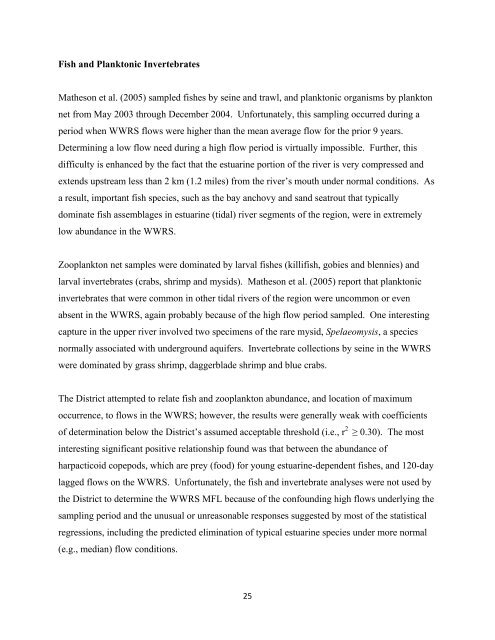Weeki Wachee River System Recommended Minimum Flows and ...
Weeki Wachee River System Recommended Minimum Flows and ...
Weeki Wachee River System Recommended Minimum Flows and ...
Create successful ePaper yourself
Turn your PDF publications into a flip-book with our unique Google optimized e-Paper software.
Fish <strong>and</strong> Planktonic Invertebrates<br />
Matheson et al. (2005) sampled fishes by seine <strong>and</strong> trawl, <strong>and</strong> planktonic organisms by plankton<br />
net from May 2003 through December 2004. Unfortunately, this sampling occurred during a<br />
period when WWRS flows were higher than the mean average flow for the prior 9 years.<br />
Determining a low flow need during a high flow period is virtually impossible. Further, this<br />
difficulty is enhanced by the fact that the estuarine portion of the river is very compressed <strong>and</strong><br />
extends upstream less than 2 km (1.2 miles) from the river’s mouth under normal conditions. As<br />
a result, important fish species, such as the bay anchovy <strong>and</strong> s<strong>and</strong> seatrout that typically<br />
dominate fish assemblages in estuarine (tidal) river segments of the region, were in extremely<br />
low abundance in the WWRS.<br />
Zooplankton net samples were dominated by larval fishes (killifish, gobies <strong>and</strong> blennies) <strong>and</strong><br />
larval invertebrates (crabs, shrimp <strong>and</strong> mysids). Matheson et al. (2005) report that planktonic<br />
invertebrates that were common in other tidal rivers of the region were uncommon or even<br />
absent in the WWRS, again probably because of the high flow period sampled. One interesting<br />
capture in the upper river involved two specimens of the rare mysid, Spelaeomysis, a species<br />
normally associated with underground aquifers. Invertebrate collections by seine in the WWRS<br />
were dominated by grass shrimp, daggerblade shrimp <strong>and</strong> blue crabs.<br />
The District attempted to relate fish <strong>and</strong> zooplankton abundance, <strong>and</strong> location of maximum<br />
occurrence, to flows in the WWRS; however, the results were generally weak with coefficients<br />
of determination below the District’s assumed acceptable threshold (i.e., r 2 ≥ 0.30). The most<br />
interesting significant positive relationship found was that between the abundance of<br />
harpacticoid copepods, which are prey (food) for young estuarine-dependent fishes, <strong>and</strong> 120-day<br />
lagged flows on the WWRS. Unfortunately, the fish <strong>and</strong> invertebrate analyses were not used by<br />
the District to determine the WWRS MFL because of the confounding high flows underlying the<br />
sampling period <strong>and</strong> the unusual or unreasonable responses suggested by most of the statistical<br />
regressions, including the predicted elimination of typical estuarine species under more normal<br />
(e.g., median) flow conditions.<br />
25
















